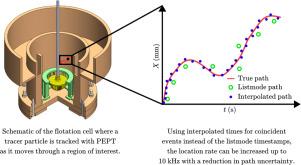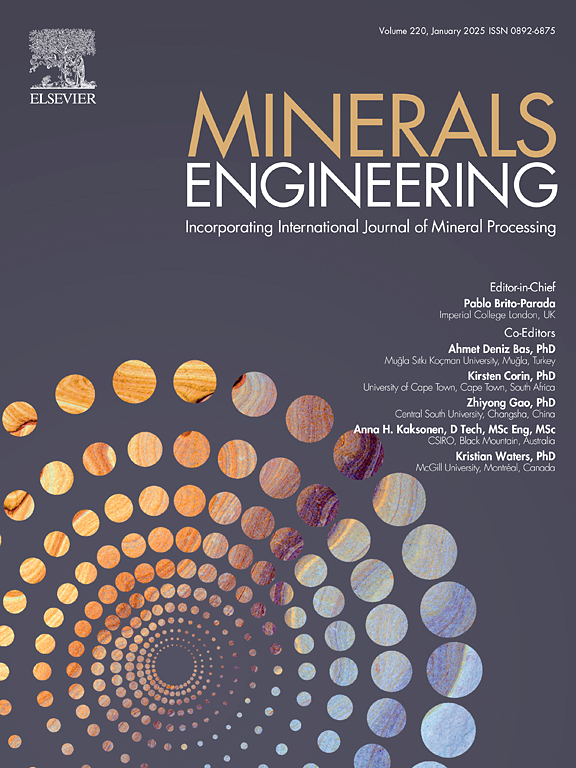提高用于泡沫浮选的正电子发射粒子跟踪(PEPT)测量的定位率
IF 4.9
2区 工程技术
Q1 ENGINEERING, CHEMICAL
引用次数: 0
摘要
一种名为正电子发射粒子跟踪(PEPT)的非侵入式技术被用于研究浮选过程中矿物粒子的动态。需要高频率跟踪,才能完全解析具有高度波动速度成分的湍流路径。跟踪频率也称为 "定位率",即每秒跟踪的位置数。在 PEPT 测量的原始数据上采用了时间插值算法,以提高 PEPT 数据的有效定位率。该算法通过开普敦 PEPT 扫描仪(开普敦大学)的西门子 ECAT "EXACT3D "HR++ PET 扫描仪进行蒙特卡洛模拟验证。模拟数据生成的路径具有改进的定时信息,其位置测量的位置和时间部分的不确定性低了一个数量级。随后,该算法被应用于在实验室规模的浮选容器中对自由移动的粒子进行的 PEPT 实验,以展示更高保真跟踪的影响。本文章由计算机程序翻译,如有差异,请以英文原文为准。

Increasing the location rate of positron emission particle tracking (PEPT) measurements for froth flotation
A non-invasive technique named positron emission particle tracking (PEPT) is used to study the dynamics of mineral particles found in froth flotation. High frequency tracking is required to fully resolve turbulent flow paths with highly fluctuating velocity components. Tracking frequency is also called “location rate”, which is the number of tracked locations per second. A time interpolation algorithm was implemented on the raw data of a PEPT measurement to increase the effective location rate of PEPT data. The algorithm was validated with Monte-Carlo simulations of the Siemens ECAT “EXACT3D” HR++ PET scanner at PEPT Cape Town (University of Cape Town). The paths generated from the simulated data with improved timing information had an order of magnitude lower uncertainty in both the position and time components of a location measurement. The algorithm was then applied to PEPT experiments with freely moving particles in a laboratory scale flotation vessel to demonstrate the impact of tracking with higher fidelity.
求助全文
通过发布文献求助,成功后即可免费获取论文全文。
去求助
来源期刊

Minerals Engineering
工程技术-工程:化工
CiteScore
8.70
自引率
18.80%
发文量
519
审稿时长
81 days
期刊介绍:
The purpose of the journal is to provide for the rapid publication of topical papers featuring the latest developments in the allied fields of mineral processing and extractive metallurgy. Its wide ranging coverage of research and practical (operating) topics includes physical separation methods, such as comminution, flotation concentration and dewatering, chemical methods such as bio-, hydro-, and electro-metallurgy, analytical techniques, process control, simulation and instrumentation, and mineralogical aspects of processing. Environmental issues, particularly those pertaining to sustainable development, will also be strongly covered.
 求助内容:
求助内容: 应助结果提醒方式:
应助结果提醒方式:


